Bulletin – June 2017 Payments The Ongoing Decline of the Cheque System
- Download 661KB
Abstract
Cheque use in Australia has declined significantly over the past few decades and currently represents only a small share of non-cash payments. This decline reflects changes in the payments market as a result of technological change and customer preferences for faster, digital payments. To ensure that the payment needs of individuals and businesses continue to be met, the payments industry has embarked on a number of initiatives to manage the decline in cheque use.
Introduction
Cheques were the most important non-cash payment method in Australia a few decades ago.[1] In 1980 cheques accounted for 85 per cent of the number of non-cash payments and almost all of their value (Mackrell 1996). The popularity of cheques was partly due to a number of features that consumers valued (see ‘Box A: Features of Cheques’) and partly due to the absence of alternative payment instruments.
However, with changing consumer preferences, the growth of other instruments such as debit and credit cards, and increasing technological payments innovations such as direct credit payments, the use of cheques has declined significantly over the past few decades. As a result, in 2016 cheques represented about 1 per cent of the number of non-cash payments, and – reflecting the higher average transaction size than for other payment types – about 7 per cent of the value of such payments.
Over 20 years ago, Mackrell noted that cheques were no longer the dominant payment instrument they were in 1980, although they were still popular with the general public. Today, cheques represent a very narrow segment of the payment system and are no longer used by the majority of the general public.
Cheque Use
Historically, cheques have played a significant role in the Australian payments system. In the mid 1990s there were close to 50 cheque payments per capita each year, more than double the number of debit card payments (Graph 1). Since then, cheque use has steadily declined, with fewer than five cheque payments per capita in 2016. In contrast, transactions using other non-cash payment methods have increased strongly, with Australians making over 200 payments per capita with debit cards and over 100 payments per capita with credit cards in 2016.
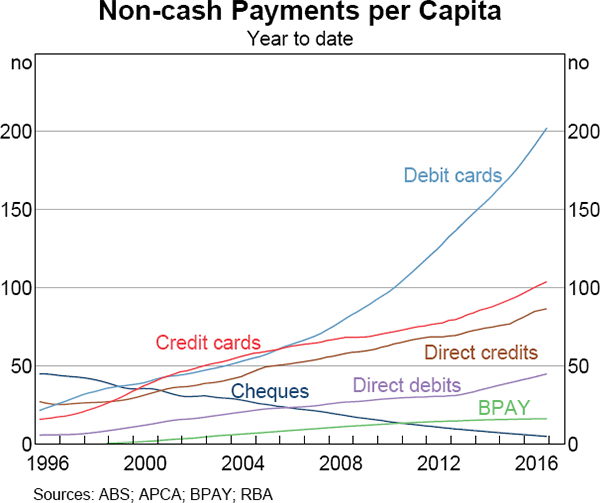
Notably, cheque use is not just declining, but declining at an increasing rate. The number of cheques written in recent years has declined significantly faster than at the start of the decade (Graph 2). Indeed, in 2016 cheque use experienced the largest percentage decline on record, with the number of cheques written falling by 20 per cent.
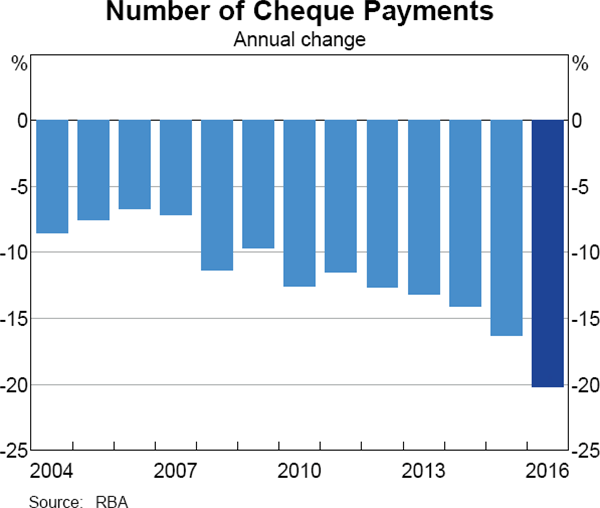
Box A
Features of Cheques
Cheques possess a number of attributes that may be valued by end users. They:
- allow physical, face-to-face, simultaneous exchange, for example, for property settlement
- can be written on a 24/7 basis, including at times when banks' systems are not operative or when the payer does not have access to a computer, mobile phone or cash
- allow additional information to accompany the payment, for instance, when an invoice or other documentation is attached to the cheque
- allow payment to be made when only limited information is known about the person to whom payment is being made
- allow significant financial control where, for instance, the need for a specific signature (or multiple signatures) provides key account signatories oversight of all outward payments within a business
- are flexible, they may be transferred to a third party (negotiable) and they may be addressed to ‘bearer’.
On the other hand, cheques have a number of less desirable attributes:
- cheques (with the exception of financial institution cheques) are typically liabilities of households or businesses and are, therefore, subject to the risk of the drawer having insufficient funds in their account
- recipients typically face significant delays in obtaining cleared funds, especially if the provision of the cheque or its deposit involves the postal service
- as a result, cheques (with the exception of financial institution cheques) are not suited to many transactions where the cheque recipient is providing goods or services that cannot be recovered in the event that the cheque is not honoured
- cheques are costly and becoming increasingly so as their use declines.
For reporting and analytical purposes cheques are divided into three categories:
- commercial cheques, written by commercial customers (mostly businesses and government entities) of a financial institution that are drawn on that institution, including cheques used to withdraw cash
- personal cheques, written by personal customers of a financial institution that are drawn on that institution
- financial institution cheques (or ‘bank cheques’), drawn by an institution on itself or on the issuing institution's own account with the drawee bank.
The decline in cheque use has been most significant for commercial and personal cheques, with the number of these cheques falling by around 13 per cent per year over the past decade, a cumulative fall of more than three-quarters (Graph 3). The number of financial institution cheques written has also declined, albeit at a slower rate. In contrast, the value of financial institution cheques written has increased over the past decade. As discussed below (see ‘Financial Institution Cheques’), this increase is likely to reflect the use of financial institution cheques for certain large-value purchases, particularly of property, for which prices have grown strongly over this period.
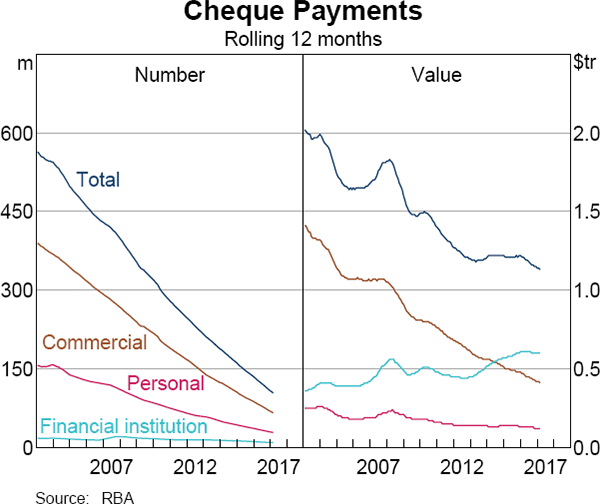
While the number of cheques written has fallen, the average value of the remaining cheque payments has risen across all cheque types, particularly over the past five years (Graph 4). This is partly a result of migration of many smaller value payments to electronic methods while cheques continue to be used for larger value payments. Industry liaison indicates that cheques are often used for amounts that exceed the limits on electronic channels and, as noted earlier, for particularly large transactions such as property purchases.
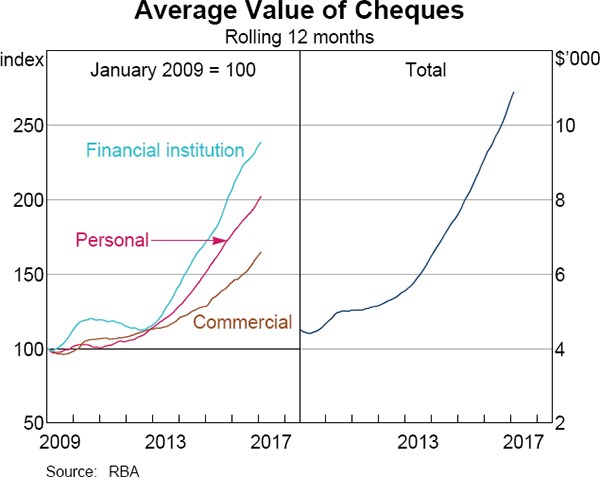
Commercial Cheques
The decline in commercial cheque use has been a long-term trend. The acceleration in this decline in the past few years has been associated with falls in both the number of bank accounts with cheque facilities and the average number of cheques written on those accounts still with cheque facilities. This partly reflects the increasing use of internet banking by businesses. Lower cheque volumes also reflect the implementation of the SuperStream reforms, which required employers to make superannuation contributions using electronic methods.[2]
Industry liaison indicates that remaining commercial cheque use is concentrated in particular industries, such as real estate and conveyancing, finance and insurance, and business services. For example, some insurance companies use cheques for payment of claims. Industry sources also suggest that small businesses tend to use cheques more than large businesses.
Traditionally, some government agencies have been significant users of cheque payments but this is changing. Federal government agencies have recently taken steps to reduce payments by cheque. For example, the Department of Human Services stopped issuing cheques for welfare payments through Centrelink in January 2016 and for the Medicare rebate and Pharmaceutical
Benefits Scheme refund payments in July 2016 (Department of Human Services 2016).
Personal Cheques
The aggregate data show a significant fall in the use of cheques by individuals, with the number of personal cheques written falling from 8 per capita in 2002 to just over 1 per capita in 2016. Further information on the use of personal cheques is provided by the Reserve Bank diary studies on consumer payments (the Consumer Payments Survey) conducted every three years since 2007. The 2016 survey found that cheques accounted for about 0.2 per cent of the total number of consumer payments during the week-long diary period, down from 1.2 per cent in 2007 (Doyle et al 2017). That is, of around 17,000 consumer payments recorded over the week of the 2016 survey, less than 40 were cheque payments. Consistent with this trend, the share of survey respondents reporting at least one personal cheque payment in the year before the survey fell to 12 per cent from around 20 per cent in 2013.
While the small number of cheque payments in the survey makes it difficult to analyse trends in detail, some broad observations can be made. Respondents to the 2016 survey indicated that the remaining cheque use is largely to pay for larger expenditures such as household bills, holidays or services (Graph 5). However, even in these segments cheques are only a small share of the total number of payments. Reflecting these larger expenditures, the 2016 survey showed a median value for cheque payments of around $135, compared with a median value of $22 for all other payments.
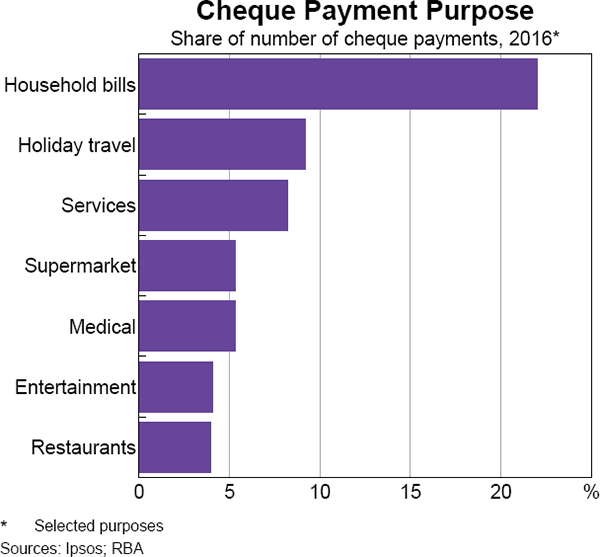
Respondents to the 2016 survey were asked the most important reason for why they used cheques. For those respondents who did use cheques, the most common responses were that some merchants prefer to be paid by cheque, there is no alternative for that particular type of payment or because cheques provide a useful record of the payment (Graph 6). Some respondents noted that cheques allow them to include more information with the payment (by attaching documents). Others noted the ‘safety’ provided by cheque payments. This might reflect that – in contrast with cards in some circumstances – writing a cheque creates very little exposure of the payer to fraud. But it might also reflect that cheques allow older or less mobile consumers to make payments for services without having to keep large amounts of cash in their homes.
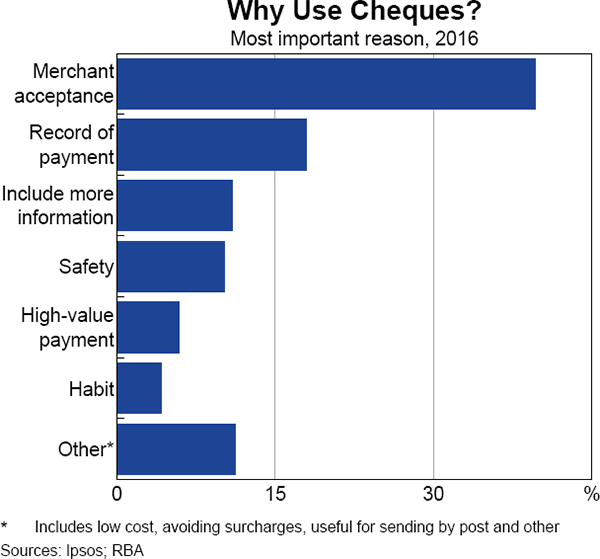
While only a few cheque users noted that cheques are useful for sending by post, in practice, half of the cheque payments recorded during the week were made by post. This use of cheques for remote payments may partially reflect a limited choice of payment instruments for some respondents. Around half of the respondents who made cheque payments during the week of the survey indicated that they did not hold a credit card and over a third reported they did not use the internet on a regular basis.
The diary surveys confirm that older consumers are more likely to use cheques (around 70 per cent of cheques recorded in the most recent survey were written by people aged 65 and above). However, they show that the fall in cheque use is occurring across all age groups (Graph 7). In 2007, cheques represented a little over 2 per cent of the number of payments made by consumers over 65 years old; in 2016 this had fallen to less than 1 per cent.
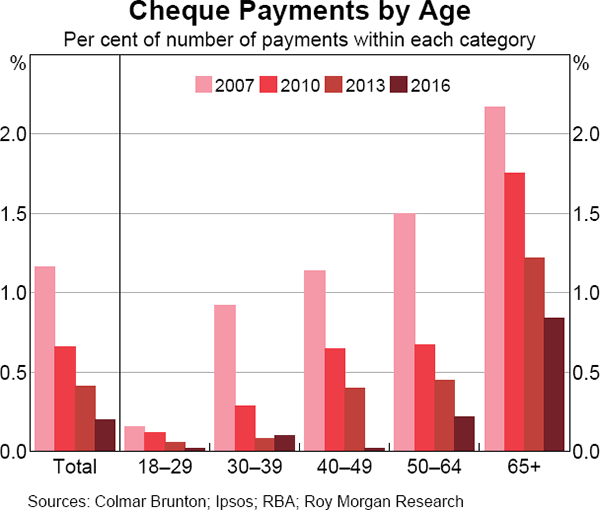
The continued fall in personal cheque use likely reflects greater availability of other payment methods as well as increasing confidence in the use of the internet and electronic payments across consumers in all age groups. Consistent with this, internet use among older Australians is rising rapidly and their largest single use of the internet is for online banking and paying bills (Graph 8).
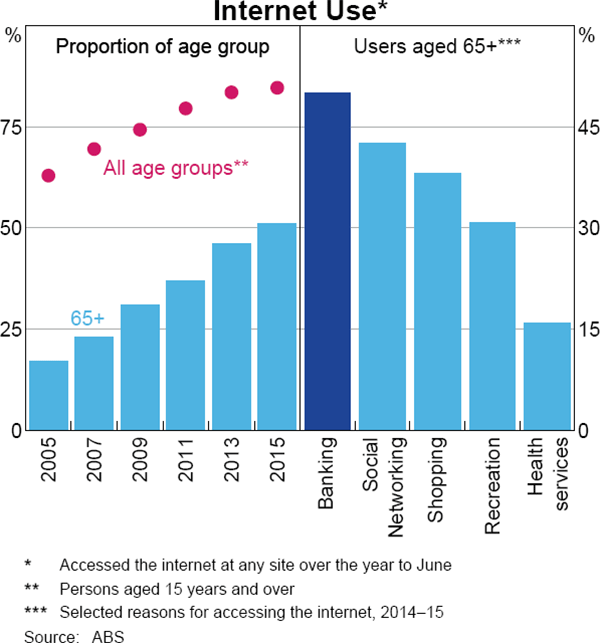
Financial Institution Cheques
While financial institution cheques represented only 9 per cent of the number of cheques written in 2016, they accounted for over half of the value of cheques, because of their much larger average value. Industry liaison indicates that the majority of the value of financial institution cheque use is in the settlement of property purchases (and related transactions such as the payment of stamp duty). Accordingly, the issuance of such cheques is correlated with indicators of property market transactions (Graph 9). Nevertheless, the use of cheques for property settlements is likely to fall in coming years as electronic conveyancing becomes more common (see ‘Industry Initiatives’ below). Industry sources also indicate that financial institution cheques are often used for other high-value purchases, for example, private sales of cars and other second-hand goods; they are also used widely for rental bonds.
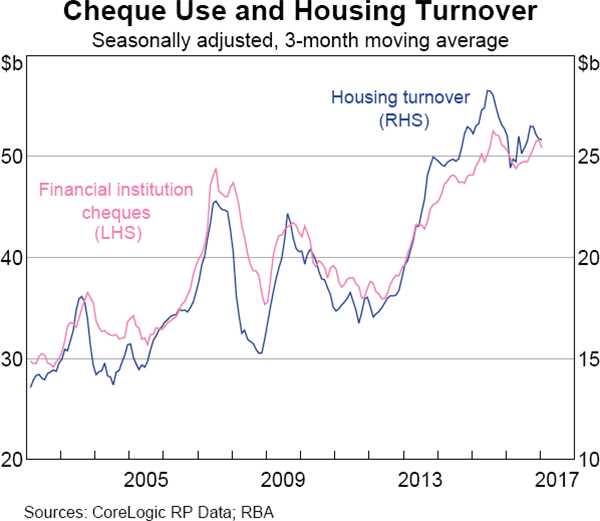
International Perspective
The decline in cheque use in Australia is consistent with global trends. A sample of 14 high-income OECD economies shows that all experienced a fall in per capita cheque use of at least 50 per cent over 2000–15 (Graph 10). Significant declines in cheque use have occurred even in some of the economies that have traditionally had very high cheque use (most notably the United States, Canada and France). As a result, many OECD countries now have a very low number of cheque transactions per capita. This includes most countries in Europe (some of which traditionally had low levels of cheque use).[3] Indeed, in at least one case the cheque system has now been closed: due to the decline in the use of cheques and their high processing costs, Dutch banks stopped issuing cheques in July 2001 and terminated processing by the end of that year.
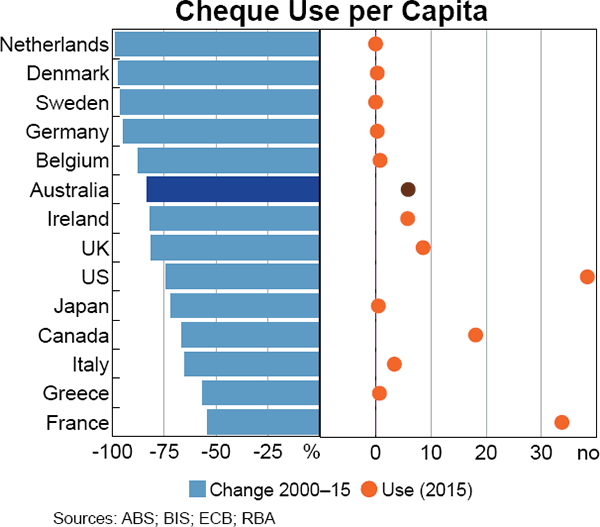
Cost and Pricing of Cheques
Cheques are a relatively costly payment instrument for financial institutions and many end users. Moreover, even though cheque use is likely to decline further, many of the overheads associated with the cheque system may remain largely unchanged, implying that average unit costs are likely to increase over time. Concerns over the cost of cheques have prompted an industry discussion of how their decline can be managed in an orderly manner (see ‘Industry Initiatives’ below).
One recent source of information on the cost of cheques is the Reserve Bank's 2014 Payment Cost Study which examined the costs borne by merchants, financial institutions and individuals in the use of different payment methods (Stewart et al 2014). Among other things, the study calculated the ‘resource costs’ of different payment methods – the economic costs incurred by participants to ‘produce’ payments of each type. While the focus of the study was on consumer-to-business payments, the results should also be relevant to payments between other sectors of the economy.
The 2014 study estimated that cheques were the most resource intensive of the commonly used payment methods by a considerable margin, costing over $5 per transaction (Graph 11). The bulk of these costs was incurred by financial institutions. However, costs to merchants were also higher than for other instruments: for example, in the case of retailers, processing times at the check-out associated with cheque transactions were significantly longer than for other payment methods. Consistent with this, a number of large merchants including Myer and David Jones have stopped accepting cheques for in-store purchases in the past few years.
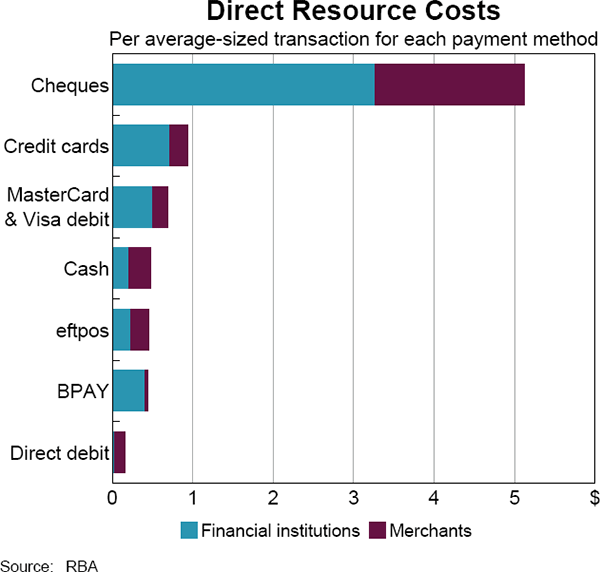
Financial institutions' pricing policies for cheques vary, based on the type of customer and account. In many cases, accounts allow for cheques to be written or deposited at no charge (though often with a monthly account fee). In those cases where customers are charged, pricing often appears to be below the resource costs suggested by the Bank's cost study.
Industry Initiatives
The payments industry in Australia has embarked on a number of initiatives to manage the decline of cheque use. These initiatives are aimed at ensuring that the evolving payment needs of individuals and businesses continue to be met at the same time as the cheque system becomes increasing costly to operate. The Reserve Bank, as a regulator of the payment system, has also contributed to the public discussion of the future of the cheque system.[4]
In 2011, the Australian Payments Network (AusPayNet, formerly known as the Australian Payments Clearing Association, APCA) commenced a public consultation on this issue. Following this consultation, AusPayNet published a report addressing the challenges presented by declining but persistent cheque use and proposing a number of measures to assist current cheque users participate in the digital economy (APCA 2012). More recently, the Australian Payments Council (APC) has highlighted these issues in its Australian Payments Plan (APC 2015).
A particularly important initiative is the New Payments Platform (NPP), scheduled for launch in late 2017. The NPP will provide a new national infrastructure for fast, flexible and data-rich payments (Bolt, Emery and Harrigan 2014). This will enable some of the features of cheques to be better replicated electronically. For example, the NPP's addressing service will facilitate easier addressing of payments, so that payers will no longer need to know Bank State Branch (BSB) and account numbers to make a payment to another individual or entity. And the NPP's message format will allow significantly more data to be transmitted with a payment than the current Direct Entry message, allowing the inclusion of more remittance information. The immediacy of NPP payments will also make them suitable for transactions requiring simultaneous exchange of the payment for goods or services, for example, used car sales. Importantly, the NPP will support various ‘overlay’ services, which will allow financial institutions to provide tailored services to meet customers' needs. These more specialised services have the potential to address many other situations where users currently feel they have little alternative but to use cheques.
Another important initiative is the shift to electronic conveyancing (e-conveyancing) which allows property settlement and the associated transfer of funds to occur electronically, using real-time gross settlement at the Reserve Bank. This process is being implemented through a joint venture company, Property Exchange Australia (PEXA), owned largely by a number of state governments and financial institutions. While the number of settlements transacted on PEXA is still moderate, and many relate to refinancing rather than property sales, activity has grown rapidly over the past two years. Reserve Bank data show that there were around 20,000 PEXA-related property settlements, including refinancing, in the March quarter 2017 (Graph 12).[5] This compares with about 120,000 sales transactions in the national housing market in the same period. It is likely that a material share of property sales will continue to shift to PEXA, reducing the value of financial institution cheques issued. In particular, four states across Australia have released timelines to transition to online property settlements over the next two years.
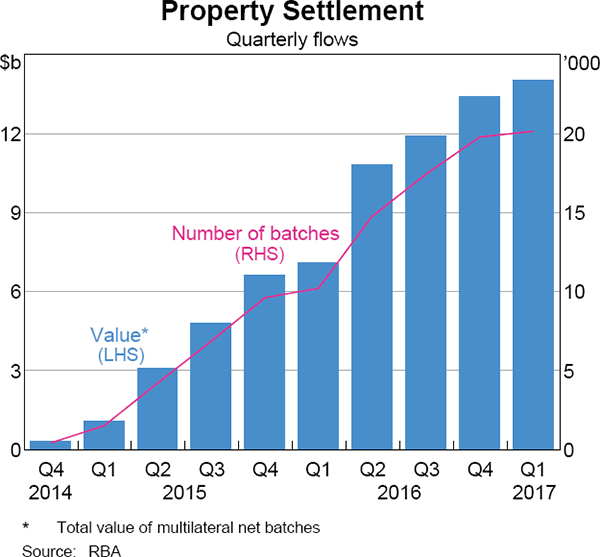
Conclusion
The number of cheque payments in Australia has declined by around 85 per cent over the past two decades, and cheques currently account for only a small share of non-cash payments. This decline has been driven by market forces amid growing availability of card and electronic payments and consumers' preference for faster payments. Furthermore, the decline has accelerated significantly in recent years. With developments such as the NPP and e-conveyancing, and as access to online payments becomes more common across all Australians, the shift away from cheques is expected to continue. As more customers take up electronic payments, more businesses and other payees are likely to stop accepting cheques.
The decline in the use of cheques has not been accompanied by any significant difficulties from users in making or receiving payments by cheque. Rather, the decline has been quite orderly and appears to have simply reflected consumers, businesses and government entities switching to other, newer payment methods that better meet their needs. The industry is working on a number of initiatives to address the ongoing decline in cheque use. These initiatives aim to ensure that the payment needs of individuals and businesses continue to be met in an efficient, low-cost manner.
Footnotes
The author is from Payments Policy Department. [*]
This article refers to non-cash retail payments that involve financial institutions. That is, the analysis excludes both transactions using cash (which do not involve a financial institution) and wholesale payments (often related to securities and large corporate transactions) that are settled via real-time gross settlement at the Reserve Bank. [1]
SuperStream is a government reform aimed at improving the efficiency of the superannuation industry, a sector that had traditionally been heavily reliant on cheques. This initiative grew out of the Cooper Review, which identified cheque use as an inefficiency in the superannuation system (Commonwealth of Australia 2010). The Review proposed the establishment of a standardised IT protocol for the electronic processing of superannuation contributions and rollovers between trustees. [2]
Some European countries traditionally used direct-entry-style giro systems for making payments. Under this system a customer wishing to make a payment lodges an instruction at their bank, which then passes on the value and payment details to the beneficiary's bank. The credit transfer characteristics of the giro system facilitated the transition to electronic payments in those European countries (Mackrell 1996). [3]
For more details see Richards (2016). [4]
More accurately, there were around 20,000 settlement batches in the quarter. In the vast majority of cases a settlement batch represents a single property transaction. A batch is a group of interbank credits and debits that are submitted to the Reserve Bank Information and Transfer System for settlement. These payment obligations must sum to $0 (i.e. the sum of the debits equals the sum of the credits). [5]
References
APC (Australian Payments Council) (2015), ‘Australian Payments Plan’, December.
APCA (Australian Payments Clearing Association) (2012), ‘The Decline of Cheques: Building a Bridge to the Digital Economy’, Final Report on the APCA public consultation ‘The role of cheques in an evolving payments system’, May.
Bolt S, D Emery and P Harrigan (2014), ‘Fast Retail Payment Systems’, RBA Bulletin, December, pp 43–51.
Commonwealth of Australia (2010), ‘Super System Review: Final Report’, June.
Department of Human Services (2016), ‘Medicare Patient Cheques Have Stopped’, Media Release, 24 June.
Doyle M-A, C Fisher, E Tellez and A Yadav (2017), ‘How Australians Pay: New Survey Evidence’, RBA Bulletin, March, pp 59–65.
Mackrell NC (1996), ‘Cheques and the Payments System’, RBA Bulletin, October, pp 26–31.
Richards T (2016), ‘The Ongoing Evolution of the Australian Payments System’, Speech at the Payments Innovation 2016 Conference, Sydney, 23 February.
Stewart C, I Chan, C Ossolinski, D Halperin and P Ryan (2014), ‘The Evolution of Payment Costs in Australia’, RBA Research Discussion Paper No 2014-14.